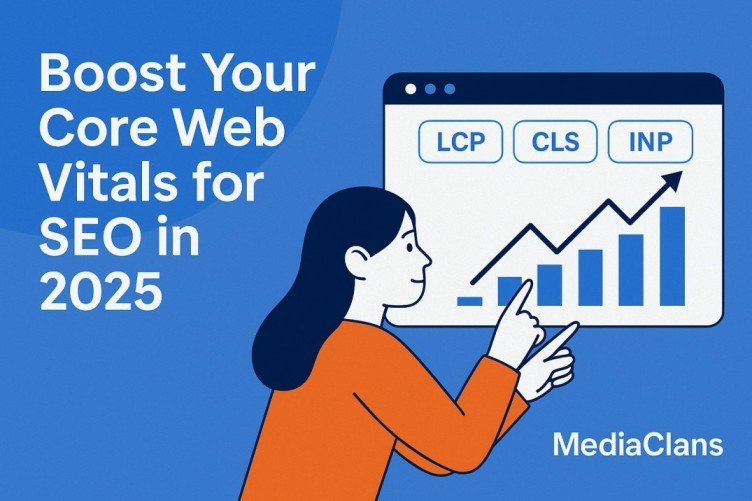
As we step into 2025, Core Web Vitals are no longer just a technical SEO metric; they’re a critical ranking signal and a user experience benchmark. Google continues to push for a web that’s faster, smoother, and more user-focused. If you’re looking to dominate SERPs and delight your visitors, optimizing Core Web Vitals is a must.
In this guest post, we’ll break down what Core Web Vitals are, why they matter more than ever in 2025, and how businesses can proactively improve them. Plus, we’ll share actionable tips and how working with experts like MediaClans can make the optimization process faster and more effective.
What Are Core Web Vitals?
Core Web Vitals are a set of metrics introduced by Google to measure real-world user experience across three key dimensions:
- LCP (Largest Contentful Paint): Measures loading performance. Aim for <2.5 seconds.
- CLS (Cumulative Layout Shift): Measures visual stability. Aim for <0.1.
- INP (Interaction to Next Paint): Replaces FID and measures responsiveness. Aim for <200 ms.
These metrics directly impact SEO rankings, bounce rates, and conversion rates, especially on mobile. A poor score in any of these areas may lead to reduced search visibility, higher exit rates, and lower engagement levels.
To compete effectively, brands must go beyond aesthetics and content—they must deliver smooth, fast, and interruption-free browsing experiences.
Why Core Web Vitals Matter More in 2025
Google’s ranking algorithms are increasingly UX-focused. As AI-generated content floods the web, performance metrics become a key differentiator. Fast, stable, and responsive websites:
- Rank higher on Google
- Improve user satisfaction
- Drive better engagement and conversions
- Reduce bounce rates and increase dwell time
With mobile-first indexing now fully adopted, ensuring fast and seamless performance on mobile devices has become more important than ever. Speed and responsiveness are not just technical wins they’re business advantages.
Key Optimization Areas
1. Improve Page Load Speed (LCP)
- Optimize visuals by resizing and converting them into advanced formats such as WebP to reduce load times without sacrificing quality
- Use lazy loading for below-the-fold images
- Minify JavaScript & CSS
- Implementing a Content Delivery Network (CDN) can significantly enhance load speed and reduce latency for users across different regions
- Defer non-critical third-party scripts
- Optimize server response times
2. Reduce Layout Shifts (CLS)
- Ensure that your media elements, such as images and videos, have predefined width and height properties to prevent layout shifts
- Avoid inserting new UI elements above existing content
- Use font-display: swap to prevent FOIT (Flash of Invisible Text)
- Implement skeleton screens for a smoother load
- Monitor third-party widget behavior (e.g., ads, forms)
3. Enhance Responsiveness (INP)
- Reduce input delay by eliminating long tasks
- Divide complex JavaScript functions into smaller, asynchronous modules to minimize delays and improve interactivity
- Prioritize input latency in your mobile optimization strategy
- Optimize thread blocking time
- Prefetch and preload critical assets
Explore how interaction delays impact user retention and satisfaction.
Tools to Monitor Core Web Vitals
Regularly assess your site’s health and speed using a combination of diagnostic tools such as:
- Google PageSpeed Insights
- Lighthouse (in Chrome DevTools)
- Web Vitals Extension
- Search Console Core Web Vitals Report
- GTmetrix and Pingdom for performance simulation across regions
Regular monitoring helps you fix issues proactively—before they impact your rankings or conversions.
How MediaClans Can Help
While you can perform many optimizations in-house, working with digital experts like MediaClans ensures a comprehensive, data-driven approach. The agency combines:
- Real-time performance audits
- UX and technical SEO integration
- Custom Core Web Vitals strategies
- CRO (Conversion Rate Optimization) aligned with speed improvements
- Hands-on implementation across mobile and desktop platforms
Whether you’re an eCommerce brand, SaaS business, or local service provider, MediaClans tailors its Core Web Vitals strategies to your specific business goals. Their team bridges the gap between design and development, ensuring measurable uplift in performance.
Bonus: 2025 Trends Impacting Core Web Vitals
- AI-heavy websites are slower optimize rendering paths
- More traffic comes from mobile-first index prioritize mobile responsiveness
- User expectations for speed and stability are rising
- Serverless technologies are improving time-to-first-byte (TTFB)
- Browser-based machine learning is reshaping page behavior
Stay ahead by aligning design, development, and SEO with performance goals.
Final Thoughts
Core Web Vitals aren’t optional; they’re foundational to a high-performing website in 2025. They influence your visibility, conversions, and user satisfaction. Whether you’re running a blog, an enterprise-level eCommerce store, or a service website, performance matters.
With Google doubling down on UX signals, the time to act is now. Start by auditing your site’s performance and if you need expert guidance, trust professionals like MediaClans to deliver measurable results.
Ready to rank higher and retain more users?

